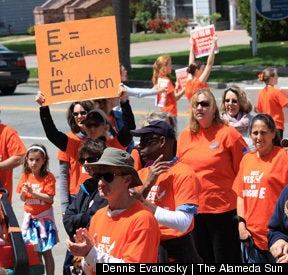
Tonight, in a little strip-mall office next to the local Safeway, a teenage student from Alameda, California will spend the evening dialing up strangers to make an earnest request: please save my school.
The budget ax is about to fall on this Bay Area city. Seven million dollars in K-12 education cuts are planned this year, nearly $10 million will be lopped off next year, and a massive $17 million cut looms in 2012. A few weeks ago, Alameda's Board of Education handed out pink slips to 130 teachers, administrators and staff.
"This is the worst yet," said Superintendent Kirsten Vital, a 20-year veteran of California's education system. "I've never seen anything like it."
And so this month, Vital and a host of parents and students are fighting to pass a "parcel tax" -- basically a flat tax on landowners -- the latest trend in last-ditch efforts to save California's schools.
Unlike with big congressional elections, the campaign to shore up this 10,000-student district runs along on a relative shoe-string budget.
"It's a volunteer army," Vital said. Local residents have "organized block captains, everyone has a caseload. Tuesday through Thursday nights we have 65 to 70 high school students on the phone, doing phone-banking. It's totally a volunteer effort."
The situation in Alameda isn't unique. Parents across the state, including in four other Bay Area counties, have placed parcel taxes on the ballot next Tuesday to make up for sharply reduced school funding.
Last year, California raised $251 million from parcel taxes, according to the Education Data Partnership, despite the fact that they require two-thirds supermajorities to become law. (Alameda's measure would cost residential property owners $659 per year.)
Indeed, schools in Alameda are already funded by a parcel tax that passed in 2008 by the slimmest of margins, 39 votes. Just to maintain current funding levels, another parcel tax of double the amount is needed. "That is to preserve what we have, not to add new programming for young people," Vital said.
And what happens if the measure doesn't pass? It's a grim picture.
Class sizes will grow, from 20 students on average to 25 or even 32. Meanwhile, students' time in class will drop; they'll leave school early as partial days increase, and the total number of school days will be cut by a week.
Teachers and staff will have targets on their backs. All employees will face furlough days, and many teachers -- particularly the next generation of young educators who today are the least experienced -- will be let go. (A bill currently working its way through Congress would provide funding to prevent 300,000 education lay-offs.)
The teachers who keep their jobs will receive no professional development or coaching -- those training days are eliminated. Also on the chopping block are field trips and various enrichment experiences, which already are funded heavily by volunteer community auctions and fundraisers.
The shifts in class size and teaching time impact students immediately. "They'll have different work assigned, maybe not as much writing and reading," Vital explained, "because when teachers have more students, they're not able to assign the same level of work."
The end result, she admits, is that fewer students will meet their grade level standards. "I think that's just the truth. When you defund, this is what happens. And then what happens -- for a kindergartener this year, imagine as they move to first grade, to second grade, what that means as a cost to society when kids are not reading or doing math at grade level."
